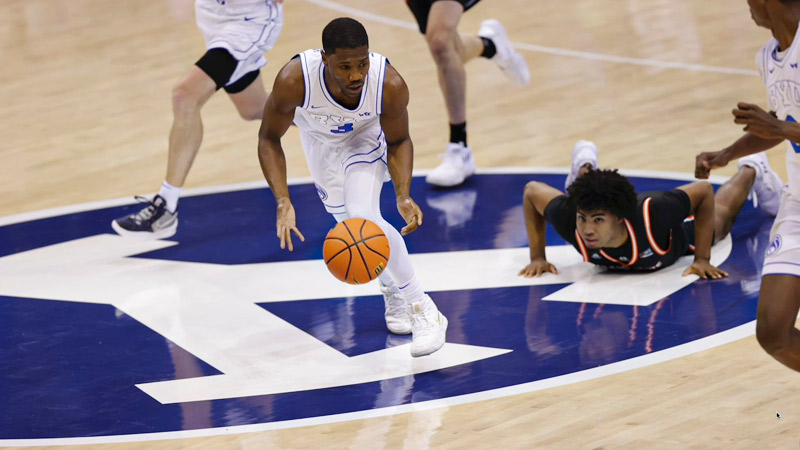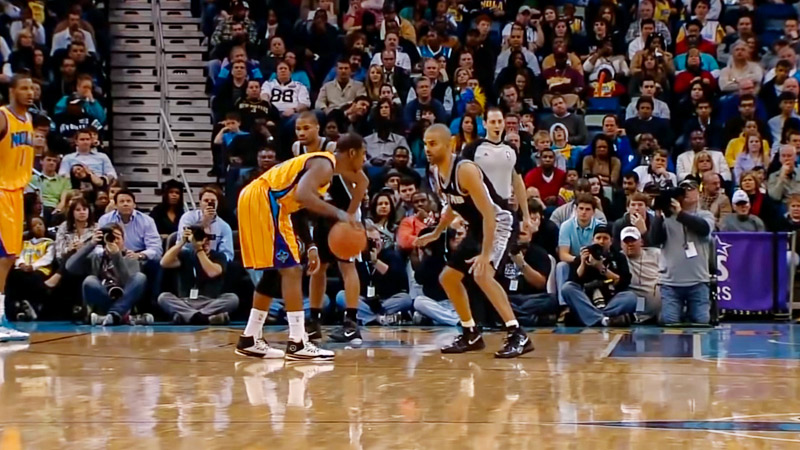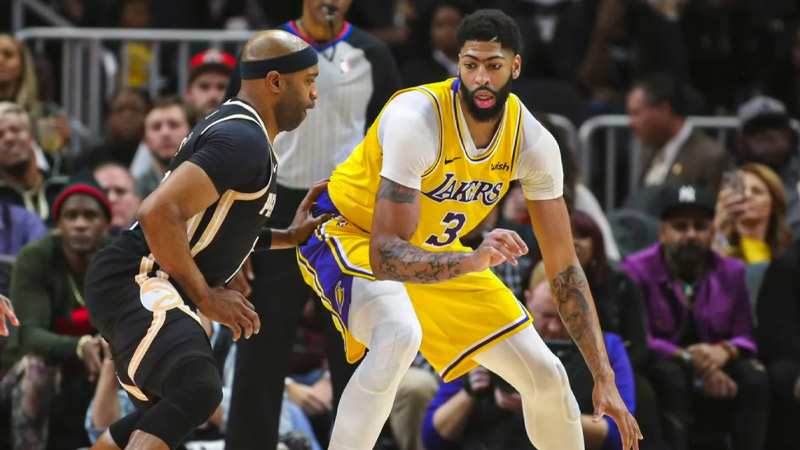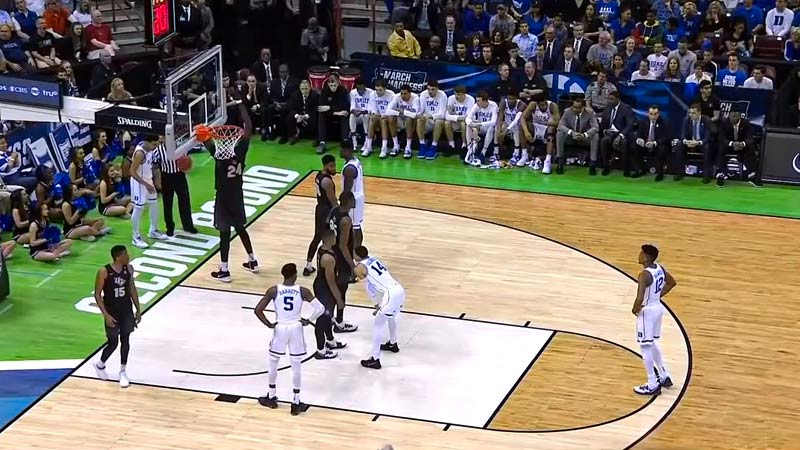Basketball is a dynamic and fast-paced sport that relies on various positions to achieve team success. The backcourt is a critical basketball court area that plays a vital role in team strategy and gameplay. But what is backcourt in basketball?
The backcourt refers to the court area occupied by the team’s guards, namely the point guard and the shooting guard. These players are positioned at the back of the offensive and defensive formations, acting as the primary ball handlers, playmakers, and perimeter scorers.
Their skills, decision-making, and coordination greatly influence a team’s offensive flow, defensive stability, and overall success on the court.
Understanding the backcourt’s significance is crucial for players, coaches, and fans alike, as it sheds light on the essential roles and responsibilities these guards fulfill and how they contribute to the team’s strategic gameplay.
In this article, we will delve deeper into the backcourt, exploring its definition, importance, and impact on the dynamics of basketball teams.
What Is Backcourt In Basketball?
The backcourt in basketball refers to the area occupied by the team’s guards, the point guard, and the shooting guard. These players are positioned at the back of the offensive and defensive formations, playing crucial roles in the team’s strategy and gameplay.
They are responsible for handling the ball, setting up plays, initiating the offense, and providing perimeter scoring.
Additionally, backcourt players contribute significantly to the team’s defensive efforts by guarding opposing guards, disrupting passing lanes, and applying pressure on the ball.
Roles And Responsibilities Of Backcourt Players
- The Point Guard Position: The point guard serves as the team’s primary ball handler and playmaker. They are responsible for orchestrating the offense, making decisions on the court, and setting up their teammates for scoring opportunities.
The point guard’s court vision, passing ability, and leadership skills are essential in guiding the team’s offensive flow. - The Shooting Guard Position: The shooting guard is primarily known for their scoring prowess. They are responsible for creating their shot opportunities through off-ball movement, utilizing screens, and taking advantage of their shooting skills.
Shooting guards are also tasked with defending the opposing team’s guards, applying pressure, and disrupting their offensive plays.
Skills And Techniques For Backcourt Players

- Ball-Handling And Dribbling: Backcourt players must possess excellent ball-handling skills to navigate through defenses, protect the ball, and create scoring opportunities.
Dribbling techniques such as crossovers, hesitations, and behind-the-back moves are crucial in breaking down opponents and creating space. - Shooting And Scoring: Backcourt players need to be proficient shooters to contribute offensively. They must develop a consistent shooting form, range, and accuracy from various positions on the court. Mastering shooting techniques like jump shots, pull-ups, and three-pointers enhances their scoring abilities.
- Passing And Playmaking: Backcourt players must possess exceptional passing skills to create opportunities for their teammates. They need good court vision, timing, and accuracy to deliver precise passes that exploit defensive gaps and set up open shots.
- Defensive Skills: Backcourt players play a vital role in the team’s defense, requiring them to exhibit solid on-ball and off-ball defensive skills. They must stay before their opponents, anticipate movements and contest shots, and contribute to rebounding efforts.
Strategies For Effective Backcourt Play
- Pick-And-Roll Offense: The pick-and-roll is a fundamental offensive play in basketball. Backcourt players must effectively execute this play by utilizing screens, making the right reads, and making accurate passes or scoring themselves.
Communication, timing, and decision-making are key factors in successfully implementing the pick-and-roll. - Transition Offense And Fast Breaks: Backcourt players excel in fast-break situations due to their speed and agility. They must make quick decisions, either attacking the rim, finding open teammates, or pulling up for shots.
Capitalizing on transition opportunities can lead to easy baskets and disrupt the opponent’s defense. - Defensive Strategies: Backcourt players must adopt various defensive strategies based on the opponent’s style of play. This includes applying pressure, denying passing lanes, making deflections, and providing help defense.
Communication and coordination within the backcourt are vital for effective defensive rotations and switches.
Roles And Responsibilities Of Backcourt Players

Backcourt players in basketball, comprising the point guard and shooting guard positions, are pivotal in dictating the game’s flow and contributing to their team’s success.
Each position carries distinct responsibilities and expectations, showcasing their unique skill sets and contributions on both courts.
Point Guard Position
The point guard serves as the team’s primary playmaker and orchestrator of the offense. Their ball-handling and playmaking responsibilities involve:
- Maintaining control of the ball.
- Making accurate passes.
- Creating scoring opportunities for teammates.
They are responsible for setting up the offense, running plays, and making quick decisions based on the defense they face.
Additionally, point guards are crucial in the team’s defense, providing on-ball pressure, initiating defensive rotations, and assuming on-court leadership responsibilities.
Shooting Guard Position
Shooting guards are primarily known for their scoring prowess and shooting abilities. They possess a combination of shooting accuracy, range, and shot-creation skills that allow them to contribute points to the team’s offensive output.
Off-ball movement and creating scoring opportunities through cuts, screens, and spacing are integral to their role.
Defensively, shooting guards guard the opposing team’s guard, using their athleticism and defensive instincts to disrupt plays and limit scoring opportunities.
Complementary Skills And Teamwork
Regardless of their specific positions, backcourt players must work together cohesively to maximize their impact on the game.
Their ability to communicate, complement each other’s skills, and develop a shared understanding of the team’s goals and strategies is crucial. This teamwork allows for effective offensive execution, defensive rotations, and overall success for the team.
Notable Backcourt Duos
Throughout basketball history, numerous legendary backcourt duos have exemplified the significance of cohesive and talented guard play. Duos such as
Michael Jordan and Scottie Pippen, Magic Johnson and Byron Scott, John Stockton and Jeff Hornacek, Stephen Curry and Klay Thompson, and Isiah Thomas and Joe Dumars have showcased the power of dynamic backcourt partnerships in achieving team success.
Evolving Roles And Modern Trends
In recent years, the roles of backcourt players have evolved with changes in game style, strategies, and player versatility. The rise of “combo guards” who can interchangeably play point guard and shooting guard positions has become more prevalent.
Additionally, the emphasis on three-point shooting, versatility on defense, and offensive creativity has shaped the expectations and responsibilities placed upon modern backcourt players.
Prospects And Impact
The backcourt remains a crucial component of basketball teams, with its impact extending beyond individual skill sets. The successful implementation of backcourt strategies and the ability of guards to adapt to evolving trends will continue to influence the game’s future.
Developing and nurturing talented backcourt players will remain a priority for teams aspiring to achieve sustained success.
Skills And Techniques For Backcourt Players

Mastering various skills and techniques is essential for backcourt players in basketball. From ball-handling and shooting to passing and defense, the backcourt players must possess diverse abilities to excel.
Ball-Handling And Dribbling
Practical ball-handling skills are crucial for backcourt players as they navigate the defense and create scoring opportunities. It involves maintaining control of the ball while protecting it from opponents.
Different dribbling moves, such as crossovers, behind-the-back dribbles, and hesitation dribbles, deceive defenders and create separation. Developing court vision and awareness while dribbling enables players to identify open teammates and make accurate passes.
Shooting And Scoring
Backcourt players must possess solid shooting techniques to contribute points to their offense. Mastering the fundamentals, such as proper shooting form, footwork, and follow-through, is essential.
Understanding different shot types, including jump shots, layups, and floaters, allows players to adapt to various defensive situations. They need to read the defense, create scoring opportunities through off-ball movement, and make effective decisions when taking shots.
Passing And Playmaking
Backcourt players play a significant role in facilitating the offense by delivering accurate and timely passes. They must understand different passing techniques like bounce passes, chest passes, and lobs and utilize them based on the situation.
Backcourt players enhance the team’s offensive efficiency by creating opportunities for their teammates through playmaking. This involves making intelligent decisions, understanding their teammates’ strengths, and exploiting defensive weaknesses.
Defensive Skills
Defensive skills are equally crucial for backcourt players to disrupt opponents’ offense and prevent scoring opportunities. On-ball defense requires staying before the opponent, applying pressure, and preventing dribble penetration.
Off-ball defense involves understanding help-side rotations, supporting teammates, and effectively closing passing lanes. Backcourt players must also be able to anticipate passes, make steals, and disrupt the flow of the opponent’s offense.
Communication And Leadership
Apart from individual skills, backcourt players often take up the role of on-court leaders. They must communicate effectively with their teammates, provide instructions, and direct the team’s offensive and defensive strategies.
Leadership qualities such as decision-making, composure under pressure, and setting the game’s tempo are crucial for backcourt players to guide their team to success.
Mental Toughness And Resilience
Backcourt players face intense pressure during games, requiring mental toughness and resilience. They must remain focused, handle defensive pressure, and make split-second decisions while facing tight defenses.
Developing mental toughness allows backcourt players to overcome challenges, adapt to changing game situations, and confidently lead their teams.
Conditioning And Fitness
Backcourt players are often involved in a high-paced style of play, requiring excellent conditioning and fitness levels. They need to possess endurance, agility, and quickness to keep up with the demands of the game.
Regular physical training, including cardiovascular exercises, strength training, and agility drills, helps backcourt players maintain peak performance throughout the season.
Frequently Asked Questions
Can players from other positions be part of the backcourt?
While guards primarily occupy the backcourt, teams can occasionally have forwards or centers with exceptional ball-handling skills and playmaking abilities.
However, traditional backcourt players are usually guards due to their skill set and agility.
What is the difference between a shooting guard and a small forward?
Although shooting guards and small forwards may share similarities, their primary distinction lies in their position and responsibilities.
Shooting guards generally operate in the backcourt, focusing on scoring and shooting. At the same time, small forwards play closer to the frontcourt and may have more versatility in their role.
Are there any famous backcourt duos in basketball history?
Yes, basketball history is replete with legendary backcourt duos that have left an indelible mark on the game.
Examples include Michael Jordan and Scottie Pippen (Chicago Bulls), Magic Johnson and Jerry West (Los Angeles Lakers), and Stephen Curry and Klay Thompson (Golden State Warriors), among many others.
What are some key skills required for backcourt players?
Backcourt players must possess excellent ball-handling skills, court vision, passing ability, shooting accuracy, and defensive prowess. They should also have a high basketball IQ, decision-making ability, and ability to adapt to different game situations.
Can backcourt players excel in both offense and defense?
Absolutely. Many notable backcourt players have demonstrated exceptional skills on both ends. They contribute significantly to their team’s offense through scoring, playmaking, and outside shooting. They also excel in defensive efforts such as steals, deflections, and on-ball pressure.
Conclusion
The backcourt plays a pivotal role in basketball, contributing to the offensive and defensive aspects. Point and shooting guards, with their unique skill sets, roles, and responsibilities, are essential to any successful team.
Understanding the significance of the backcourt and the skills required for backcourt players is crucial for aspiring basketball enthusiasts.
By mastering the skills and strategies of the backcourt, players can enhance their overall game and contribute to their team’s success on the court.







